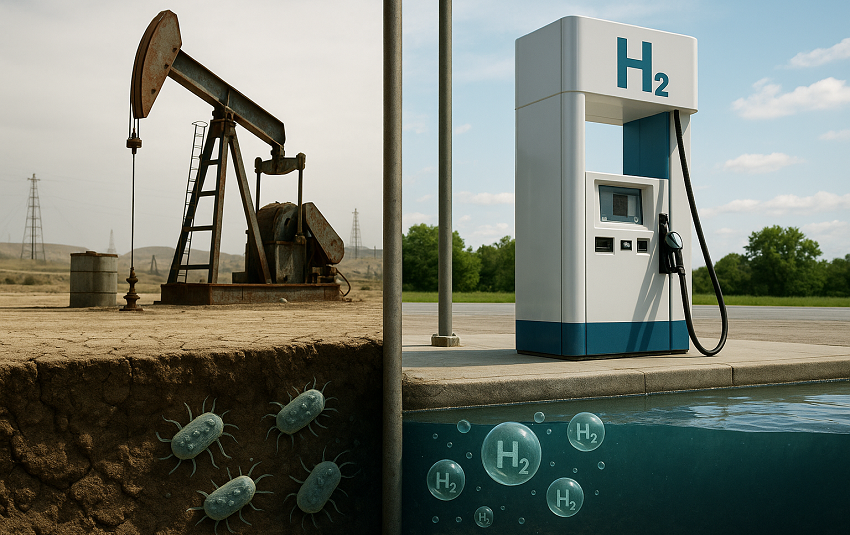Bio-stimulated Hydrogen: Unlocking Clean Energy from Legacy Oil Infrastructure

What if the world’s abandoned oil wells could become the backbone of tomorrow’s clean hydrogen economy? A new class of hydrogen production—called bio-stimulated hydrogen—promises just that. This process leverages subterranean microbial communities to convert leftover hydrocarbons in depleted oil reservoirs into hydrogen gas. The microbes, either naturally present or introduced, are activated by nutrient injections and generate hydrogen as a metabolic byproduct.
Gold H₂, a California-based climate-tech innovator, is leading the charge. In a world-first commercial-scale field trial in California’s San Joaquin Basin, the company demonstrated the viability of bio-stimulated hydrogen, achieving a 40% hydrogen concentration (400,000 parts per million) in raw gas. The breakthrough came without the need for surface-intensive facilities, marking a leap forward in clean energy scalability, cost-efficiency, and infrastructure reuse.
This achievement marks more than just a technological breakthrough—it represents a scalable, economically competitive solution for repurposing oil and gas assets in the clean energy transition.
How Bio-Stimulated Hydrogen Works
At its core, bio-stimulated hydrogen production relies on microbial conversion of residual hydrocarbons. When introduced or naturally occurring microbes are stimulated via nutrient injection, they metabolize leftover hydrocarbons in the oil reservoir and release hydrogen as a metabolic byproduct.
What sets this technology apart is its ability to leverage existing oilfield infrastructure—wellbores, piping, and production systems—reducing costs and avoiding the need for new development. By repurposing aging wells, the process also extends the productive lifespan of legacy energy assets, supporting a capital-efficient transition.
“Bio-stimulated Hydrogen revives stranded oil assets and aligns with both energy transition goals and investor mandates.”
Comparative Overview: Hydrogen Production Methods
Hydrogen’s role in decarbonizing hard-to-abate sectors is well recognized, but production methods vary widely in cost, emissions intensity, and infrastructure requirements. A comparative snapshot underscores the potential of the bio-stimulated method:
| Method | H₂ Purity | Cost (USD/kg) | CO₂ Emissions | Infrastructure Needs |
|---|---|---|---|---|
| SMR (Grey) | ~75% | $1.50–2.50 | High (10–12 kg CO₂/kg H₂) | Purpose-built SMR plants |
| SMR + CCS (Blue) | ~75% | $2.00–3.50 | Moderate (2–7 kg CO₂/kg H₂) | SMR + CCS retrofits, added capex |
| Electrolysis (Green) | Up to 99.9% | $3.50–6.00 | Very low / zero (if renewable) | Electrolysers, grid upgrades, water |
| Bio-Stimulated | ~40% | $0.50–0.80 (est.) | Low (biogenic process) | Utilizes existing oilfield infrastructure |
Gold H₂ estimates that each well can produce up to 2.5 metric tons of hydrogen per day, positioning this method firmly within industrial-scale output thresholds.
Case Study: Gold H2 and ChampionX in California
When Gold H₂ set out to prove that abandoned oil wells could be transformed into hydrogen production sites, it turned to ChampionX for expertise. ChampionX is a global leader in oilfield technology, chemical solutions, and engineering services, with operations in more than 55 countries. Known for optimizing production and extending the life of energy assets, the company is now applying its capabilities to the clean energy transition.
ChampionX provided well retrofitting, nutrient injection, pressure management, and gas recovery to Gold H2, showcasing how established oilfield service providers can support the clean energy transition. “ChampionX is proud to have supported this pioneering effort,” said Deric Bryant, COO and President.
Strategic Advantages of Bio-Stimulated Hydrogen
Several advantages make this approach compelling from both a technical and investment perspective:
- No New Drilling or Capex-Heavy Infrastructure: By utilizing existing wells and subsurface formations, the technology sidesteps the permitting delays and capital intensity of green hydrogen electrolysis or new SMR facilities.
- Cost-Competitive Output: Preliminary projections suggest production costs under $0.50/kg—substantially lower than green or blue hydrogen, and on par with or below grey hydrogen.
- High Yield, Field-Proven Performance: The San Joaquin Basin pilot demonstrated 40% hydrogen purity in raw gas and consistent output from a commercial reservoir.
- Scalability Across Depleted Oil Basins: California alone could yield up to 250 billion kg of hydrogen, sufficient to power Los Angeles for 50+ years, while avoiding ~1 billion tonnes of CO₂ emissions.
- Low Carbon Intensity: As a microbial conversion process, emissions are primarily limited to indirect energy use, with no combustion or CO₂ byproduct—addressing sustainability requirements for clean hydrogen tax credits and Scope 3 emissions reduction targets.
Implications for Institutional Investors and Asset Managers
The emergence of scalable, low-cost hydrogen sourced from repurposed oil infrastructure holds several implications:
- Revives Abandoned Assets: Thousands of inactive oil wells across North America may represent underutilized clean energy production capacity—a key area for asset owners looking to mitigate write-down risk or extract post-carbon value.
- Compelling Project Economics: Low production costs (<$0.50/kg) and minimal upfront capex offer favorable risk-return dynamics, especially compared to green hydrogen developers with multi-year build timelines and grid dependency.
- Supports Climate Mandates: For investors seeking measurable climate impact, it offers real-world deployment pathways for Scope 3 emissions reduction, avoided emissions and clean hydrogen incentives.
Policy Tailwinds
The U.S. government has historically taken a central role in accelerating clean hydrogen deployment through a combination of subsidies, tax incentives, and strategic infrastructure investments. Under the Inflation Reduction Act (IRA), producers of clean hydrogen are eligible for the 45V Production Tax Credit (PTC)—offering up to $3.00 per kilogram for hydrogen with near-zero lifecycle emissions.
However, under the Trump administration, significant portions of this support have been scaled back or frozen, creating uncertainty across the sector. Several high-profile hydrogen projects have been paused or canceled, and only the most shovel-ready hydrogen hubs appear likely to move forward. While 45V tax credits remain law, proposals to shorten timelines and narrow eligibility windows could diminish their long-term value.
For bio-stimulated hydrogen, which boasts low lifecycle emissions and minimal energy inputs, these changes present both challenges and opportunities. Although projects like Gold H2’s may still qualify under the existing 45V framework, tighter timelines and funding competition may favor initiatives that can demonstrate near-term scalability and policy alignment.
Amid this shifting landscape, private capital and strategic partnerships may become even more crucial to advancing first-of-a-kind deployments. While the Department of Energy’s Hydrogen Hub initiative continues to direct billions toward regional ecosystems, fewer projects may ultimately be funded under revised criteria.
Mapping the Road Ahead for Bio-Stimulated Hydrogen
As interest in low-carbon hydrogen grows, further research, policy clarity, and financial innovation will be essential to unlock the full potential of bio-stimulated production. The successful demonstration by Gold H2 suggests that legacy oilfield infrastructure can be reimagined as part of the clean energy future—provided regulatory and investment frameworks evolve accordingly.
Robust due diligence will play a critical role in evaluating emerging technologies like bio-stimulated hydrogen. Stakeholders must assess factors such as lifecycle emissions, scalability, regulatory alignment, and long-term economic viability. This process is especially vital in today’s policy environment, where incentives and support mechanisms are shifting.
FFI Solutions supports investors, asset managers, and developers through its Climate Advisory Services, offering customized due diligence, carbon impact analysis, policy risk assessment, and technology readiness evaluations. These services are complemented by the FFI Expert Network, a curated group of energy, finance, and policy professionals who provide real-world insight into the commercial and regulatory pathways for innovative technologies.
Bio-stimulated hydrogen offers a transformative path for clean hydrogen production by utilizing legacy oil infrastructure and microbial science. With low costs, minimal infrastructure needs, and proven field performance, it represents a scalable, commercially viable solution that bridges the fossil past and the net-zero future.

Divyansh Jajoo
Divyansh Jajoo is Sustainability Research Analyst Intern at FFI Solutions.
